slf4j初始化绑定源码分析
通过阅读源码研究一下 Slf4j 是如何在运行时绑定具体的log api实现。
源码追踪
slf4j-api的源码
我们来看看slf4j的源代码,看当这段常见的写日志代码在第一次执行时,slf4j会如何工作
Logger logger = LoggerFactory.getLogger(SomeClass.class);
logger.debug("first log");
打开类 org.slf4j.LoggerFactory的源码,看到getLogger()方法的代码如下:
public static Logger getLogger(String name) {
ILoggerFactory iLoggerFactory = getILoggerFactory();
return iLoggerFactory.getLogger(name);
}
继续看 getILoggerFactory()方法的代码实现:
static int INITIALIZATION_STATE = UNINITIALIZED;
public static ILoggerFactory getILoggerFactory() {
if (INITIALIZATION_STATE == UNINITIALIZED) {
INITIALIZATION_STATE = ONGOING_INITIALIZATION;
performInitialization();
}
switch (INITIALIZATION_STATE) {
case SUCCESSFUL_INITIALIZATION:
return StaticLoggerBinder.getSingleton().getLoggerFactory();
...
}
这里涉及到一个名为INITIALIZATION_STATE 的静态变量,用来记录当前初始化的状态。默认是UNINITIALIZED,第一次调用getILoggerFactory()方法时,检查到INITIALIZATION_STATE == UNINITIALIZED,就会调用performInitialization()方法来进行初始化。
performInitialization()方法在初始化完成时,会设置INITIALIZATION_STATE为SUCCESSFUL_INITIALIZATION。这样后面的switch语句就会调用StaticLoggerBinder.getSingleton().getLoggerFactory()来返回需要的ILoggerFactory。
我们继续深入看performInitialization()方法的代码实现:
private final static void performInitialization() {
bind();
if (INITIALIZATION_STATE == SUCCESSFUL_INITIALIZATION) {
versionSanityCheck();
}
}
继续看bind()方法,忽略错误处理的代码:
private final static void bind() {
try {
Set staticLoggerBinderPathSet = findPossibleStaticLoggerBinderPathSet();
reportMultipleBindingAmbiguity(staticLoggerBinderPathSet);
// the next line does the binding
StaticLoggerBinder.getSingleton();
INITIALIZATION_STATE = SUCCESSFUL_INITIALIZATION;
reportActualBinding(staticLoggerBinderPathSet);
emitSubstituteLoggerWarning();
} ......
}
这里是关键代码了,findPossibleStaticLoggerBinderPathSet()方法用来查找当前classpath下可能的StaticLoggerBinder的实现,如果有多个的话,则reportMultipleBindingAmbiguity()和reportActualBinding()方法会在绑定前后打印相应的信息。
看findPossibleStaticLoggerBinderPathSet()里面干了什么:
private static String STATIC_LOGGER_BINDER_PATH = "org/slf4j/impl/StaticLoggerBinder.class";
private static Set findPossibleStaticLoggerBinderPathSet() {
// use Set instead of list in order to deal with bug #138
// LinkedHashSet appropriate here because it preserves insertion order during iteration
Set staticLoggerBinderPathSet = new LinkedHashSet();
try {
ClassLoader loggerFactoryClassLoader = LoggerFactory.class
.getClassLoader();
Enumeration paths;
if (loggerFactoryClassLoader == null) {
paths = ClassLoader.getSystemResources(STATIC_LOGGER_BINDER_PATH);
} else {
paths = loggerFactoryClassLoader
.getResources(STATIC_LOGGER_BINDER_PATH);
}
while (paths.hasMoreElements()) {
URL path = (URL) paths.nextElement();
staticLoggerBinderPathSet.add(path);
}
} catch (IOException ioe) {
Util.report("Error getting resources from path", ioe);
}
return staticLoggerBinderPathSet;
}
忽略细节,findPossibleStaticLoggerBinderPathSet()方法其实就是通过classloader的getResources()方法找到所有的名为”org/slf4j/impl/StaticLoggerBinder.class”的resource。
我们再回来看bind()方法,其实真正绑定的代码只有一行
import org.slf4j.impl.StaticLoggerBinder;
private final static void bind() {
......
// the next line does the binding
StaticLoggerBinder.getSingleton();
......
}
这里调用了StaticLoggerBinder.getSingleton()方法。我们看StaticLoggerBinder类的权限定名,恰好和findPossibleStaticLoggerBinderPathSet()方法中查找的一致。
StaticLoggerBinder类是从哪里来的?我们看代码的时候,可以发现在slf4j-api的源代码中,的确有对应的package和类存在。
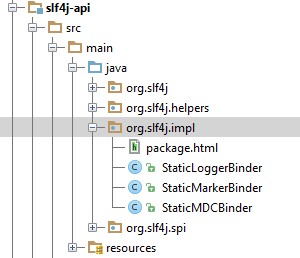
但是打开打包好的slf4j-api.jar,却发现根本没有这个implpackage。
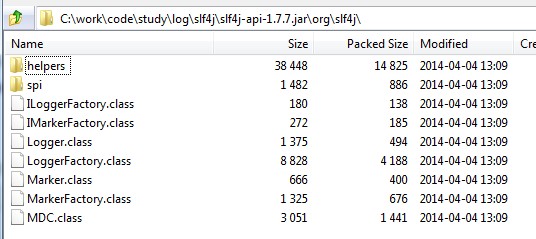
而且这个StaticLoggerBinder类的代码也明确说这个类不应当被打包到slf4j-api.jar:
private StaticLoggerBinder() {
throw new UnsupportedOperationException(
"This code should have never made it into slf4j-api.jar");
}
在slf4j-api项目的pom.xml文件中,我们可以找到下面的内容:
<plugin>
<groupId>org.apache.maven.plugins</groupId>
<artifactId>maven-antrun-plugin</artifactId>
<executions>
<execution>
<phase>process-classes</phase>
<goals>
<goal>run</goal>
</goals>
</execution>
</executions>
<configuration>
<tasks>
<echo>Removing slf4j-api's dummy StaticLoggerBinder and StaticMarkerBinder</echo>
<delete dir="target/classes/org/slf4j/impl"/>
</tasks>
</configuration>
</plugin>
这里通过调用ant在打包为jar文件前,将package org.slf4j.impl和其下的class都删除掉了。
实际上这里的impl package内的代码,只是用来占位以保证可以编译通过(所谓dummy)。需要在运行时再进行绑定。
##具体的log api的源码
我们再来看,具体的log api实现要如何做才能和slf4j绑定和装载。
slf4j自带了一个极度简化的log实现slf4j-simple,这里我们可以找到slf4j-api需要的”org/slf4j/impl/StaticLoggerBinder.class”:
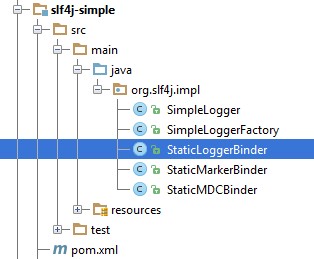
同样在slf4j-log4j12, slf4j-jkd14, slf4j-jcl的项目中可以找到类似的”org/slf4j/impl/StaticLoggerBinder.class”,这三个项目分别用于集成java社区最常见的几个log实现:log4j, jdk logging, apache common logging.
继续看回StaticLoggerBinder的代码,以slf4j-simple为例:
private final ILoggerFactory loggerFactory;
private StaticLoggerBinder() {
loggerFactory = new SimpleLoggerFactory();
}
public ILoggerFactory getLoggerFactory() {
return loggerFactory;
}
这里的getLoggerFactory()方法会返回slf4j-simple实现的SimpleLoggerFactory。
public class SimpleLoggerFactory implements ILoggerFactory {
ConcurrentMap<String, Logger> loggerMap;
public Logger getLogger(String name) {
Logger simpleLogger = loggerMap.get(name);
if (simpleLogger != null) {
return simpleLogger;
} else {
Logger newInstance = new SimpleLogger(name);
Logger oldInstance = loggerMap.putIfAbsent(name, newInstance);
return oldInstance == null ? newInstance : oldInstance;
}
}
}
SimpleLoggerFactory实现slf4j定义的ILoggerFactory interface,getLogger()方法中负责创建SimpleLogger对象并返回(为了提高性能做了cache)。
类似的slf4j-log4j12中会返回Log4jLoggerFactory,而Log4jLoggerFactory中通过调用log4j的LogManager来创建log4j的Logger对象并通过Log4jLoggerAdapter类来包装为slf4j的Logger(adapter模式)。
log4jLogger = LogManager.getLogger(name);
Logger newInstance = new Log4jLoggerAdapter(log4jLogger);
代码和类分析
初始化流程中涉及到的类:
- org.slf4j.Logger
- org.slf4j.LoggerFactory
- org.slf4j.ILoggerFactory
- org.slf4j.impl.StaticLoggerBinder
- org.slf4j.ILoggerFactory
- 具体log api的Logger实现类
Logger和LoggerFactory是slf4j定义好的,业务代码通过LoggerFactory来创建Logger对象,并调用这个logger对象来写日志。业务代码在此时是无需知道(也无法知道)具体底层是哪个log api实现,从而摆脱对具体log api的依赖。
LoggerFactory通过装载StaticLoggerBinder类来绑定具体的log api实现,得到该log api实现ILoggerFactory接口的类示例。
这个ILoggerFactory接口的类示例调用底层log api的实现来获取需要logger。
这里有个细节,如果该Logger类已经实现了org.slf4j.Logger这个interface,就直接返回。比如绑定slf4j-simple时:
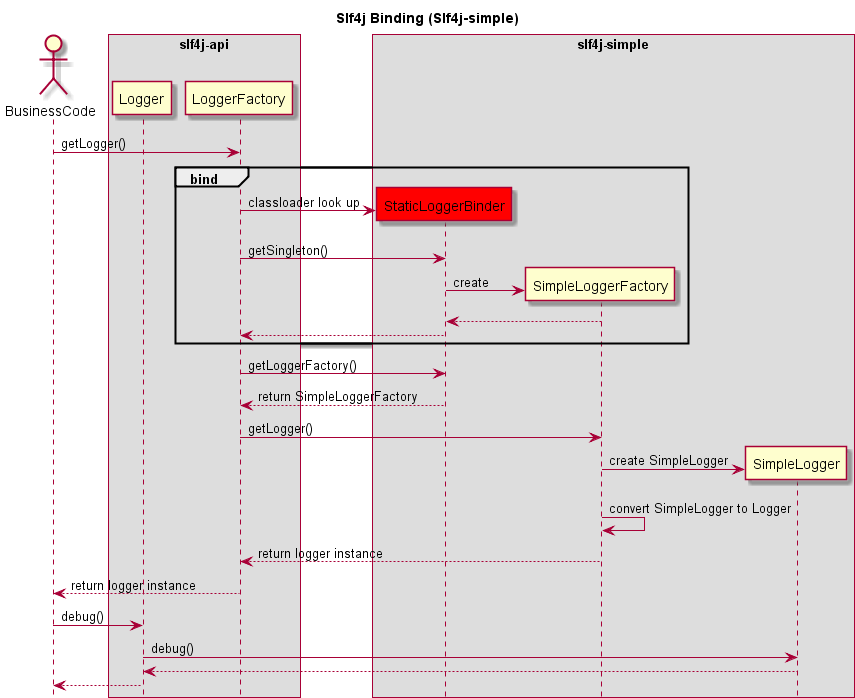
如果没有,比如Log4j的Logger,肯定不会实现org.slf4j.Logger这个interface,这时就需要包装为slf4j的Logger。在slf4j-log4jl2中,有一个Log4jLoggerAdapter类,实现了org.slf4j.Logger, 然后将方法调用转发给log4j的Logger:
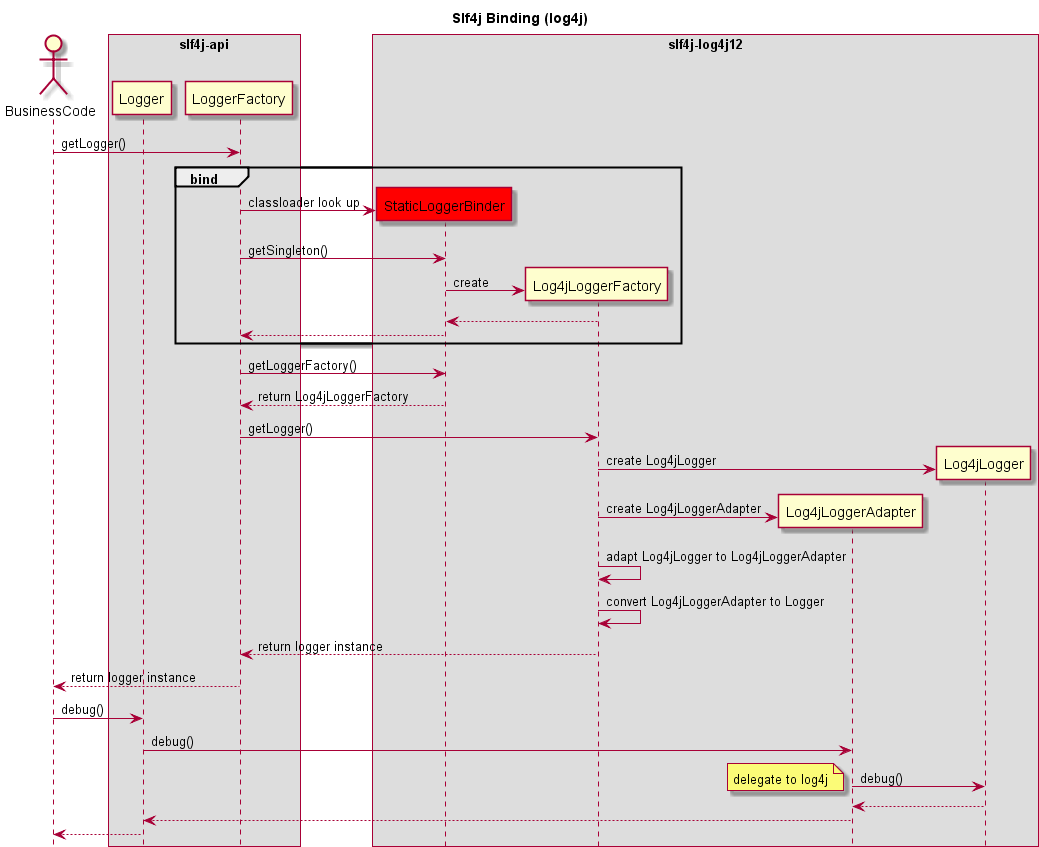
总结
通过翻看Slf4j的代码,我们可以清楚的看到slf4j在运行时绑定具体的log api实现的方式。其实非常简单,关键之处就在于 org.slf4j.impl.StaticLoggerBinder 。

